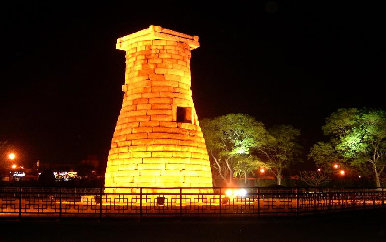Cheomseongdae Observatory - A Star Gazing Tower And National Treasure 31
The Cheomseongdae Observatory in South Korea history is one of the oldest structures in Korea.
Meaning "Star Gazing Tower" it was designated as National Treasure 31 and built during the reign of Queen Seonduk of the Old Silla Kingdom in 634. It is the oldest existing observatory in the Far East and one of the oldest scientific installations on earth.
Cheomseongdae Observatory in South Korea is a unique bottle-shaped building which was used as an astronomical observatory.
The base is 5.7 meters or 17 ft wide and stands 9.4 meters or 31 ft tall. The granite-brick construction is similar to the method employed at Bunhwangsa Temple which was inspired by the architectural patterns prevalent during the Tang Dynasty in China.

Twenty-seven layers of granite cut like brick support the upper bars of stone that form the top platform. The number 27 need mention here, since, very interestingly, Queen Seonduk was the 27th ruler of the Shilla Dynasty.
The ends of the parallel bars jut out several inches from the surface and might have been a support for a staircase used to reach the top.
The 12 rectangular base stones are placed in a square, three on each side, representing the four seasons and twelve months of each year. The 12 levels of stone to the window entrance and 12 tiers above the window opening also represent the 12 months of the year or the 12 signs of the zodiac. For over 2000 years, astronomers studied the movements of the stars and planets and charted them. They foreshadowed solar and lunar eclipses as well as the courses of comets.
Court astrologers reported and interpreted their predictions to the King who would then act according to their predictions. The stars determined all aspects of policy making, agricultural developments, celebrations, wars and other events and festivals.
Astrology pays a significant gold in molding people's views of life and the universe in South Korea.
Cheomseongdae Observatory Back to Historic Sites





